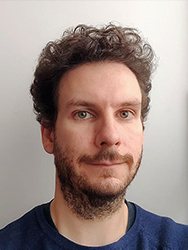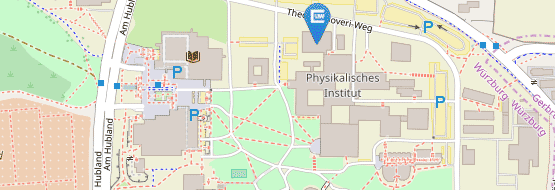Dr. Simon Betzold
Dr. Simon Betzold
University of Würzburg
Am Hubland

The focus of the hybrid polaritonics group, led by Simon Betzold, is set on the investigation of light-matter coupled systems. Of particular interest are microcavities with integrated low dimensional materials, such as quantum wells, organic emitters or monolayer materials.
Polaritonics
High quality microcavities with embedded quantum wells allow for investigation of strong coupling between excitons and photons. This light-matter hybridization gives rise to new quasiparticles, the so-called exciton polaritons. Their energy momentum dispersion E(k) can be measured directly by angle resolved spectroscopy. Polaritons are bosons and can undergo a condensation process at rather high temperatures (up to ~ 100 K in GaAs). III-V semiconductors offer the unique possibility to excite these condensates not only optically but also electrically. Our current research interests include optimization of electrically driven polariton condesates, detailed studies of their coherence properties, and the fabrication of advanced polaritonic devices.
Organic photonics
Our research focuses on the exploration and exploitation of the unique optical properties offered by organic semiconductors. We embed the organic materials in high-quality optical microcavities and investigate the interactions between organic excitons and the cavity field. On the one hand, organic solids can act as active gain material and may turn the system into the regime of stimulated emission. On the other hand, when suitable resonators are used, organic semiconductors enable the observation of strong light-matter interaction effects by serving as active exciton reservoir in the strongly coupled exciton-photon system. They provide a robust platform for the investigation of polariton physics at room temperature.
Hybrid organic-inorganic systems
We aim at demonstrating the room-temperature operation of an electrically driven polariton laser that combines the outstanding properties of both inorganic and organic semiconductors. Inorganic semiconductor microcavities are commonly used for polariton experiments as a consequence of the precise control that is achieved over nearly all material parameters with modern epitaxial deposition technologies. However, main issues such as room-temperature stability of the strong coupling regime as a result of exciton dissociation remain challenging. In contrast to that, organic semiconductors provide record high exciton stability due to a strong localization of particles but lack high charge carrier concentrations as well as processability and stability during sample fabrication. A combination of both inorganic and organic semiconductors as active layers would then comprise the room-temperature operation and high radiation efficiency of specific organics and the device-applicability of inorganics. This will enable new technologies in medical imaging and quantum communication.
| WiSe24/25 | Exercise class Optik- und Quantenphysik 1 |
| Lab course F-Praktikum: Optical Spectroscopy | |
| Lab course Physikalisches Praktikum im Nebenfach Physik | |
| SoSe24 | Lab course F-Praktikum: Optical Spectroscopy |
| Lab course Physikalisches Praktikum im Nebenfach Physik | |
| WiSe23/24 | Lab course F-Praktikum: Optical Spectroscopy |
| WiSe21/22 | Exercise class Optical Properties of Semiconductor Nanostructures |
| Lab course Physikalisches Praktikum im Nebenfach Physik | |
| Lab course F-Praktikum: Optical Spectroscopy | |
| SoSe21 | Lab course Physikalisches Praktikum im Nebenfach Physik |
Enwrapped Perylene Bisimide Enables Room Temperature Polariton Lasing and Photonic Lattices
D. Horneber, J. Düreth, T. Schembri, S. Betzold, M. Stolte, S. Höfling, F. Würthner, and S. Klembt
Adv. Opt. Mater. (2025), DOI: 10.1002/adom.202402617
Topological Optical Waveguiding of Exciton‐Polariton Condensates
J. Beierlein, O. A. Egorov, P. Gagel, T. H. Harder, A. Wolf, M. Emmerling, S. Betzold, F. Jabeen, L. Ma, S. Höfling, U. Peschel, and S. Klembt
Ann. Phys. (Berl.) (2024), DOI: 10.1002/andp.202400229
Dirac Cones and Room Temperature Polariton Lasing Evidenced in an Organic Honeycomb Lattice
S. Betzold, J. Düreth, M. Dusel, M. Emmerling, A. Bieganowska, J. Ohmer, U. Fischer, S. Höfling, and S. Klembt
Adv. Sci., e2400672 (2024), DOI: 10.1002/advs.202400672
An Electrically Pumped Topological Polariton Laser
P. Gagel, O. A. Egorov, F. Dzimira, J. Beierlein, M. Emmerling, A. Wolf, F. Jabeen, S. Betzold, U. Peschel, S. Höfling, C. Schneider, and S. Klembt
Nano Lett. (2024), DOI: 10.1021/acs.nanolett.4c00958
Polarized and Unpolarized Emission from a Single Emitter in a Bullseye Resonator
G. Peniakov, Q. Buchinger, M. Helal, S. Betzold, Y. Reum, M. B. Rota, G. Ronco, M. Beccaceci, T. M. Krieger, S. F. C. Da Silva, A. Rastelli, R. Trotta, A. Pfenning, S. Höfling, and T. Huber-Loyola
Laser Photonics Rev. (2024), DOI: 10.1002/lpor.202300835
Optical properties of circular Bragg gratings with labyrinth geometry to enable electrical contacts
Q. Buchinger, S. Betzold, S. Höfling, and T. Huber-Loyola
Appl. Phys. Lett. 122, 111110 (2023), DOI: 10.1063/5.0136715
Electro-optical Switching of a Topological Polariton Laser
P. Gagel, T. H. Harder, S. Betzold, O. A. Egorov, J. Beierlein, H. Suchomel, M. Emmerling, A. Wolf, U. Peschel, S. Höfling, C. Schneider, and S. Klembt
ACS Photonics 9, 405 (2022), DOI: 10.1021/acsphotonics.1c01605
Room-Temperature Topological Polariton Laser in an Organic Lattice
M. Dusel, S. Betzold, T. H. Harder, M. Emmerling, J. Beierlein, J. Ohmer, U. Fischer, R. Thomale, C. Schneider, S. Höfling, and S. Klembt
Nano Lett. 21, 6398 (2021), DOI: 10.1021/acs.nanolett.1c00661
Purcell-Enhanced Single Photon Source Based on a Deterministically Placed WSe2 Monolayer Quantum Dot in a Circular Bragg Grating Cavity
O. Iff, Q. Buchinger, M. Moczała-Dusanowska, M. Kamp, S. Betzold, M. Davanço, K. Srinivasan, S. Tongay, C. Antón-Solanas, S. Höfling, and C. Schneider
Nano Lett. 21, 4715 (2021), DOI: 10.1021/acs.nanolett.1c00978
Hyperspectral study of the coupling between trions in WSe 2 monolayers to a circular Bragg grating cavity
O. Iff, M. Davanço, S. Betzold, M. Moczała-Dusanowska, M. Wurdack, M. Emmerling, S. Höfling, and C. Schneider
C. R. Phys. 22, 1 (2021), DOI: 10.5802/crphys.76
Coherence and Interaction in Confined Room-Temperature Polariton Condensates with Frenkel Excitons
S. Betzold, M. Dusel, O. Kyriienko, C. P. Dietrich, S. Klembt, J. Ohmer, U. Fischer, I. A. Shelykh, C. Schneider, and S. Höfling
ACS Photonics 7, 384 (2020), DOI: 10.1021/acsphotonics.9b01300
Room temperature organic exciton-polariton condensate in a lattice
M. Dusel, S. Betzold, O. A. Egorov, S. Klembt, J. Ohmer, U. Fischer, S. Höfling, and C. Schneider
Nat. Commun. 11, 2863 (2020), DOI: 10.1038/s41467-020-16656-0
Optomechanical tuning of the polarization properties of micropillar cavity systems with embedded quantum dots
S. Gerhardt, M. Moczała-Dusanowska, Ł. Dusanowski, T. Huber, S. Betzold, J. Martín-Sánchez, R. Trotta, A. Predojević, S. Höfling, and C. Schneider
Phys. Rev. B 101, 245308 (2020), DOI: 10.1103/PhysRevB.101.245308
Spatio-temporal coherence in vertically emitting GaAs-based electrically driven polariton lasers
H. Suchomel, M. Klaas, S. Betzold, P. Gagel, J. Beierlein, S. Klembt, C. Schneider, and S. Höfling
Appl. Phys. Lett. 116, 171103 (2020), DOI: 10.1063/5.0007456
Polarization-dependent light-matter coupling and highly indistinguishable resonant fluorescence photons from quantum dot-micropillar cavities with elliptical cross section
S. Gerhardt, M. Deppisch, S. Betzold, T. H. Harder, T. C. H. Liew, A. Predojević, S. Höfling, and C. Schneider
Phys. Rev. B 100, 115305 (2019), DOI: 10.1103/PhysRevB.100.115305
Nonresonant spin selection methods and polarization control in exciton-polariton condensates
M. Klaas, O. A. Egorov, T. C. H. Liew, A. V. Nalitov, V. Marković, H. Suchomel, T. H. Harder, S. Betzold, E. A. Ostrovskaya, A. V. Kavokin, S. Klembt, S. Höfling, and C. Schneider
Phys. Rev. B 99, 115303 (2019), DOI: 10.1103/PhysRevB.99.115303
Polariton-lasing in microcavities filled with fluorescent proteins
S. Betzold, C. P. Dietrich, M. Dusel, M. Emmerling, L. Tropf, M. Schubert, N. M. Kronenberg, J. Ohmer, U. Fischer, M. C. Gather, and S. Höfling
Proc. SPIE, Quantum Sensing and Nano Electronics and Photonics XV, 66 (2018), DOI: 10.1117/12.2292045
Tunable Light–Matter Hybridization in Open Organic Microcavities
S. Betzold, S. Herbst, A. A. P. Trichet, J. M. Smith, F. Würthner, S. Höfling, and C. P. Dietrich
ACS Photonics 5, 90 (2018), DOI: 10.1021/acsphotonics.7b00552
Intrinsic and environmental effects on the interference properties of a high-performance quantum dot single-photon source
S. Gerhardt, J. Iles-Smith, D. P. S. McCutcheon, Y.-M. He, S. Unsleber, S. Betzold, N. Gregersen, J. Mørk, S. Höfling, and C. Schneider
Phys. Rev. B 97, 195432 (2018), DOI: 10.1103/PhysRevB.97.195432
Deterministic coupling of quantum emitters in WSe2 monolayers to plasmonic nanocavities
O. Iff, N. Lundt, S. Betzold, L. N. Tripathi, M. Emmerling, S. Tongay, Y. J. Lee, S.-H. Kwon, S. Höfling, and C. Schneider
Opt. Express 26, 25944 (2018), DOI: 10.1364/OE.26.025944
Spontaneous Emission Enhancement in Strain-Induced WSe 2 Monolayer-Based Quantum Light Sources on Metallic Surfaces
L. N. Tripathi, O. Iff, S. Betzold, Ł. Dusanowski, M. Emmerling, K. Moon, Y. J. Lee, S.-H. Kwon, S. Höfling, and C. Schneider
ACS Photonics 5, 1919 (2018), DOI: 10.1021/acsphotonics.7b01053
Observation of bosonic condensation in a hybrid monolayer MoSe2-GaAs microcavity
M. Waldherr, N. Lundt, M. Klaas, S. Betzold, M. Wurdack, V. Baumann, E. Estrecho, A. V. Nalitov, E. Cherotchenko, H. Cai, E. A. Ostrovskaya, A. V. Kavokin, S. Tongay, S. Klembt, S. Höfling, and C. Schneider
Nat. Commun. 9, 3286 (2018), DOI: 10.1038/s41467-018-05532-7
Exciton dynamics in solid-state green fluorescent protein
C. P. Dietrich, M. Siegert, S. Betzold, J. Ohmer, U. Fischer, and S. Höfling
Appl. Phys. Lett. 110, 43703 (2017), DOI: 10.1063/1.4974033
Three-dimensional photonic confinement in imprinted liquid crystalline pillar microcavities
M. Dusel, S. Betzold, S. Brodbeck, S. Herbst, F. Würthner, D. Friedrich, B. Hecht, S. Höfling, and C. P. Dietrich
Appl. Phys. Lett. 110, 201113 (2017), DOI: 10.1063/1.4983565
Valley polarized relaxation and upconversion luminescence from Tamm-plasmon trion–polaritons with a MoSe 2 monolayer
N. Lundt, P. Nagler, A. V. Nalitov, S. Klembt, M. Wurdack, S. Stoll, T. H. Harder, S. Betzold, V. Baumann, A. V. Kavokin, C. Schüller, T. Korn, S. Höfling, and C. Schneider
2d Mater. 4, 25096 (2017), DOI: 10.1088/2053-1583/aa6ef2
Observation of macroscopic valley-polarized monolayer exciton-polaritons at room temperature
N. Lundt, S. Stoll, P. Nagler, A. V. Nalitov, S. Klembt, S. Betzold, J. Goddard, E. Frieling, A. V. Kavokin, C. Schüller, T. Korn, S. Höfling, and C. Schneider
Phys. Rev. B 96 (2017), DOI: 10.1103/PhysRevB.96.241403
Room temperature strong coupling in a semiconductor microcavity with embedded AlGaAs quantum wells designed for polariton lasing
H. Suchomel, S. Kreutzer, M. Jörg, S. Brodbeck, M. Pieczarka, S. Betzold, C. P. Dietrich, G. Sęk, C. Schneider, and S. Höfling
Opt. Express 25, 24816 (2017), DOI: 10.1364/OE.25.024816
Impact of exsitu rapid thermal annealing on magneto-optical properties and oscillator strength of In(Ga)As quantum dots
T. Braun, S. Betzold, N. Lundt, M. Kamp, S. Höfling, and C. Schneider
Phys. Rev. B 93, 155307 (2016), DOI: 10.1103/PhysRevB.93.155307
Room-temperature Tamm-plasmon exciton-polaritons with a WSe2 monolayer
N. Lundt, S. Klembt, E. Cherotchenko, S. Betzold, O. Iff, A. V. Nalitov, M. Klaas, C. P. Dietrich, A. V. Kavokin, S. Höfling, and C. Schneider
Nat. Commun. 7, 13328 (2016), DOI: 10.1038/ncomms13328





